Getafe has been described as a dirty and distasteful team who are ruining football. It has gone to the extent of being described as anti-football. However, we know most teams who get labelled with these tags such as Diego Simeone’s Atlético Madrid, José Mourinho’s Inter Milan and Chelsea are known for being defensively astute.
Getafe ended their 12-year spell in La Liga when they got relegated in 15/16 to the Segunda División. A young José Bordalás was given the mantle and took them from a Segunda División team to three consecutive top 10 LaLiga finishes, to the brink of qualifying for the UEFA Champions League and onto featuring in the quarter-finals of the Europa League.
This has all been down to the immense defensive system Bordalás had instilled ever since he has taken the job at the Coliseum. In this tactical analysis, we are going to walk through a journey that will give you an analysis and tactics of Getafe’s defensive play.
Principles of Getafe’s defensive play
Jose Bordalás has instilled more than just fouls and cynical tackles into this team. He has instilled a defensive system based on intense pressing, individual duels, risk-averseness and controlling space. Bordalás ensures the latter by ensuring compactness in his team.
The intense pressing and risk-averseness lead to a chaotic game. However, Getafe thrives in this chaotic game state as they are excellent in winning individual battles. Apart from these, the top energy level enables them to keep this intensity and chaos through 90 minutes.
The essence of the intense press is to keep the opponents on their toes. Bordalás wants all of his players pressing the ball-carrier. This, in turn, allows them to create goal-scoring opportunities from turnovers, at the same time, defending against the opponents. The level of intense pressing is shown as Getafe top the charts for the number of pressures applied by teams.
They play in a rigid 4-4-2 system which allows them better control of spaces and it forces the opponents to adapt to the chaotic style of play. Getafe is rigid in the way they play. They don’t change their style even in moments when they are losing the game and they keep pressing and moving on the ball-carrier
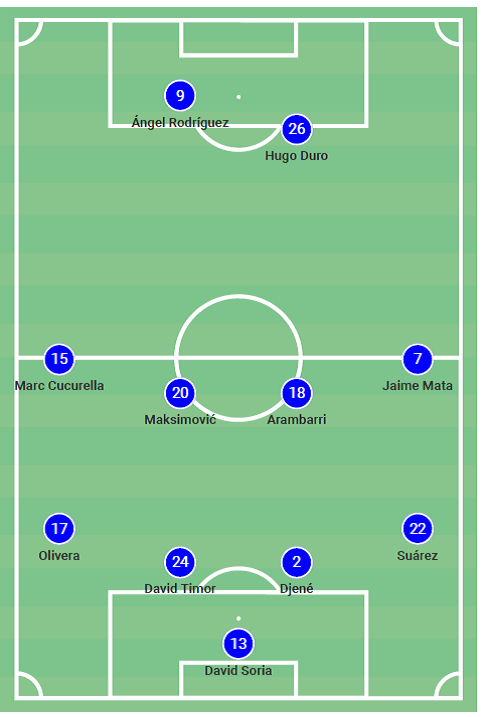
In the following sections, we’ll take a look at how Getafe apply these principles to defensive phases and situations
Gefate’s high press
A very important part of Getafe’s defensive play is their high press. This is a tactic they employ to ensure they defend far away from their goal. It helps them limit the chances that come off conceding shots and opportunities. Getafe is very effective and intense in their high-press as they boast with 7.17 PPDA (passes per defensive actions).
Getafe employs intense pressing and compactness when they high-press and will usually approach it in two forms. First of all, they press in a compact 4-3-1-2 or diamond formation with certain pressing schemes. The second option is through a man-marking press.
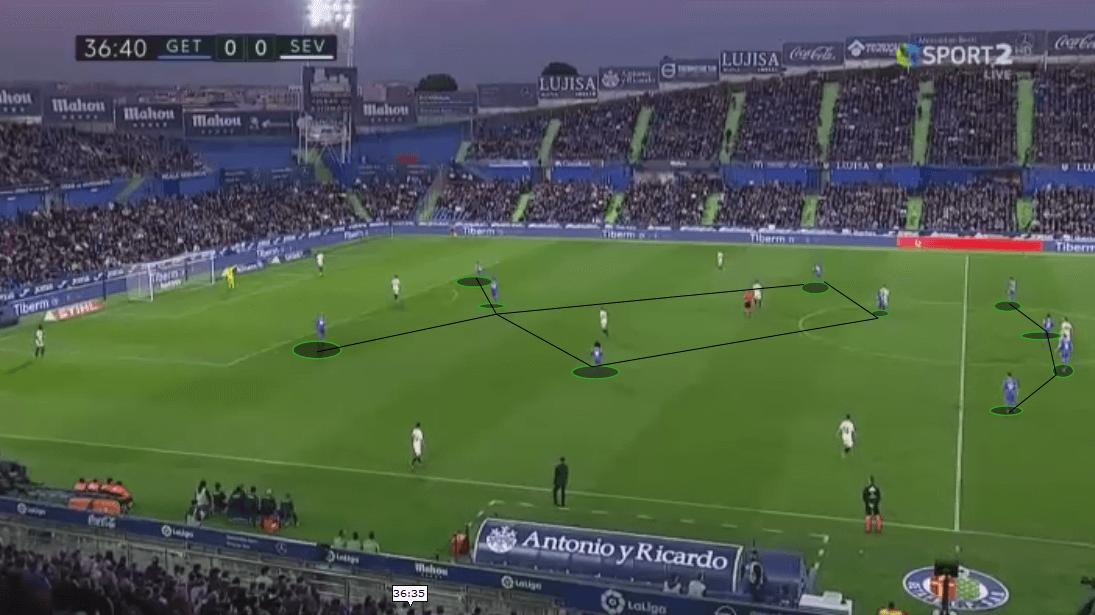
In the 4-3-1-2 press or the diamond formation, the two strikers seek to press the opposition centre-backs. A centre midfielder sets up to mark the opponent’s six. The wide players tuck in around the half-spaces to compensate for the numerical deficiency in midfield. Apart from this, the positioning in the half-space gives the wide players better access to press the full-backs in case they receive a pass. All of these patterns are shown in the below image.
The pressing scheme of Getafe using the diamond formation or the 4-3-1-2 is to ensure they stop the short passing build-up from the opponent. The ultimate aim is to force the opponent to go long as it means they lose control. They achieve this by initiating their press as they goalkeeper passes or guiding the build-up to wide areas and pressing there. They use the first pass by the goalkeeper and the pass to the full-backs as pressing triggers.
In pressing a back-three, the pressing dynamic changes due to the numerical disadvantage in the first line. The pressing trigger transfers from the goalkeeper and the full-backs to the outside centre-backs. A pass from the inner centre.back to the outer centre-back initiates a press from the ball-near centre-forward or winger. The pressing player presses at an angle and intensity that forces play wide to the wing-back. As soon as the full-back drops deep to offer a passing option, the ball-near winger or full-back triggers his press on the wing-back which likely forces a turnover or a long ball.
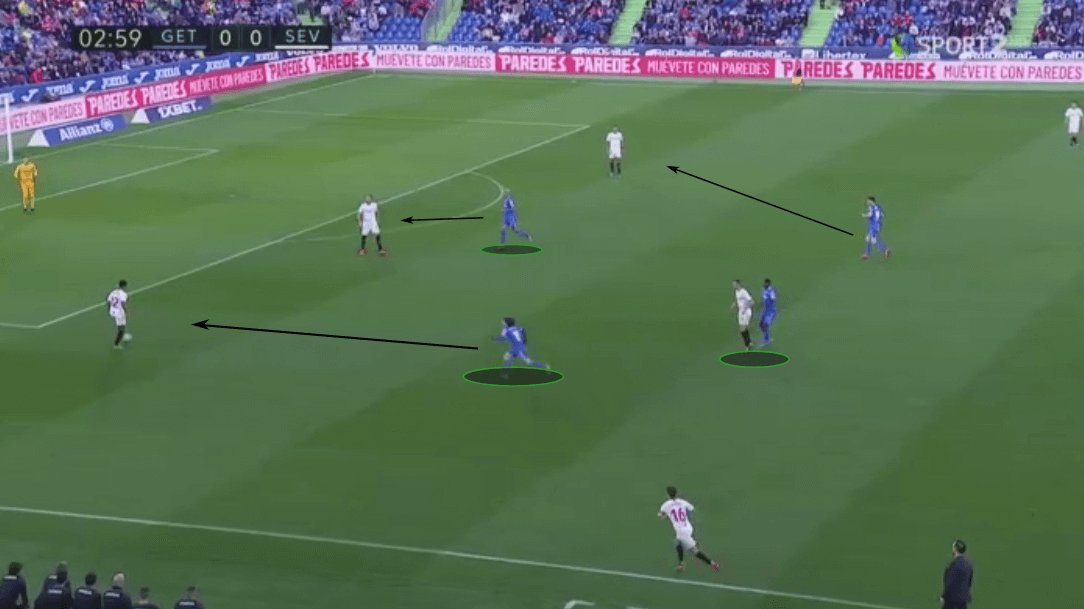
In the image above, the LW presses the RCB. The striker presses the inside centre-back, ensuring no passing option to him. The far side striker presses the third centre-back while a midfielder steps up to press the ball-side pivot.
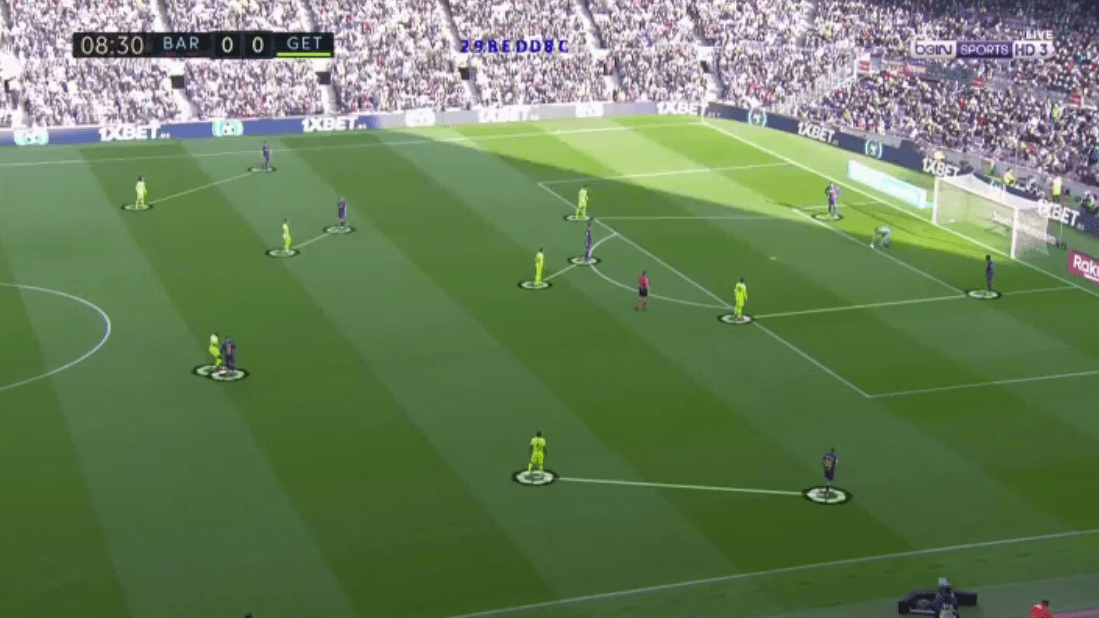
In the man-marking approach, Getafe players mark the opponents individually with the aim of winning turnovers. The intensity at which Getafe players press should be high in order to unset the ball-carrier so he can’t beat the press. The level of stamina in the Getafe team ensures it’s quite sustainable throughout the 90 minutes.
Getafe’s settled defensive play
Getafe defends in a settled shape with the aim of controlling space. In order to control the shape, Getafe uses compactness to achieve control of space. They defend in different shapes such as a compact 4-4-2, the asymmetric 5-3-2 and a 6-3-1.
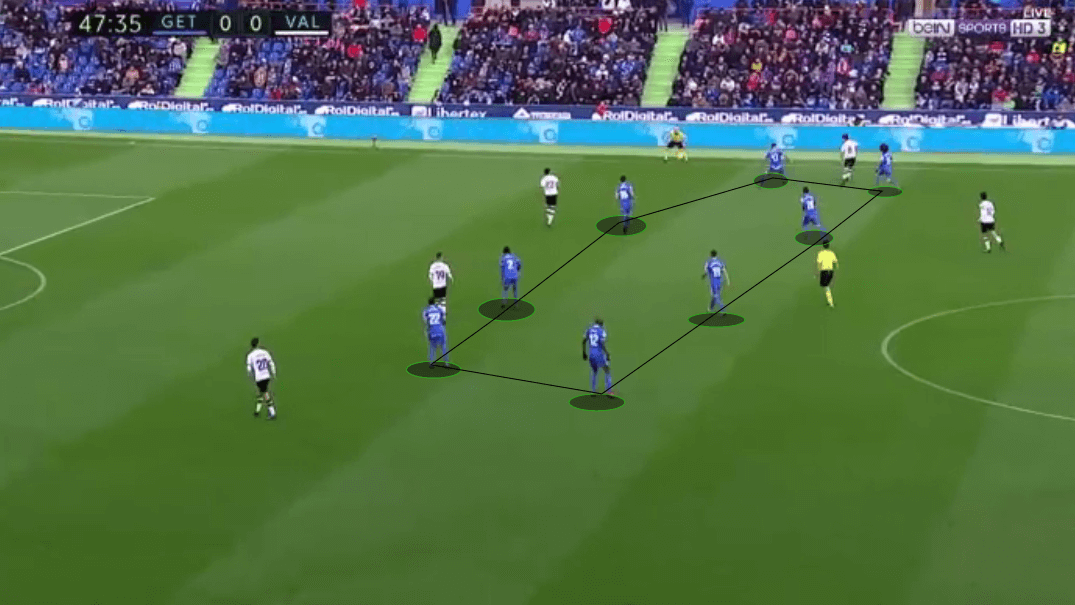
In settled defensive play, Getafe aims to protect the central areas which forces the opponents wide. The 4-4-2 is mostly used in defending central areas, especially in mid-block situations. The opponents are forced wide as there are more spaces in wide areas due to the compact or narrow shape of Getafe.
In defending wide areas, the essence of playing full-backs such as Marc Cucurella, Kenedy and Allan Nyom as wingers is shown as they help out in defending wide areas. All three use their anticipatory instincts to stop the exploitation of wide areas either by acting as false full-backs in ball-far situations in case of switches or pressing the opposition wingers in ball-near situations. The tucking in of these false full-backs creates the 6-3-1 shape.
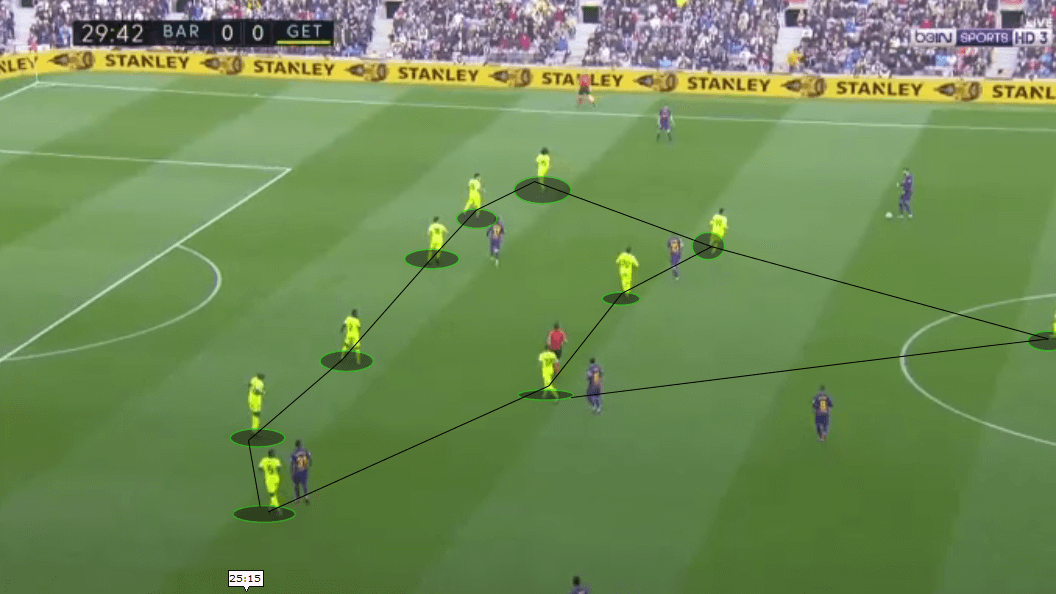
In the image above, we see the 6-3-1 shape with the wingers tucking back to act as full-backs. A striker drops into midfield, mainly Jorge Molina or the second striker to balance the numerical disadvantage.
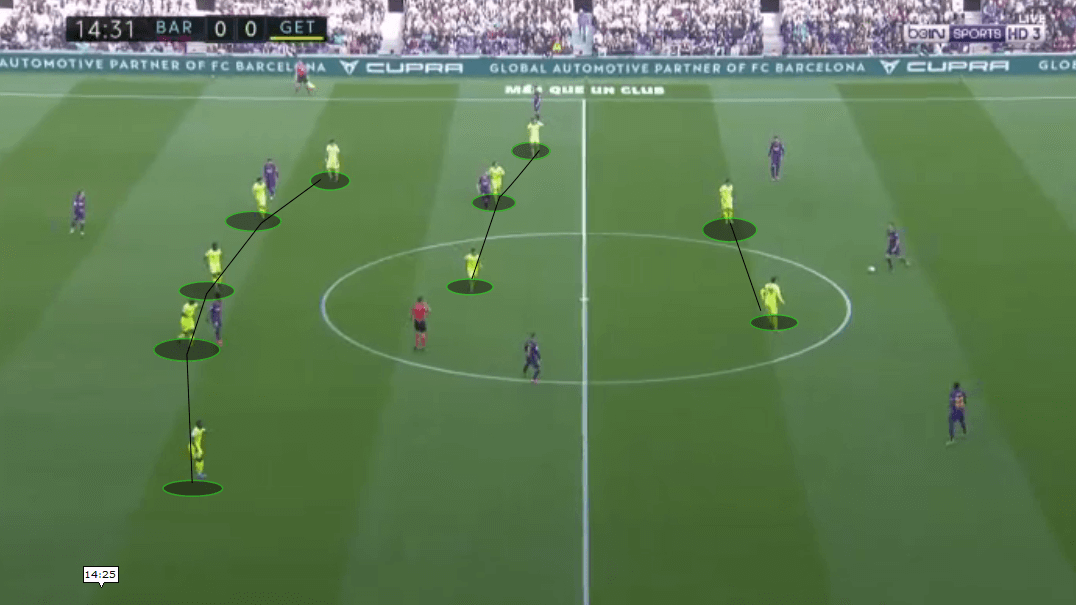
In defending against wide overloads, Getafe also employs a 5-3-2 asymmetric shape. They remain compact around wide-areas to defend against wide overloads. The asymmetric 5-3-2 is created when the ball-far winger tucks amongst the backline to defend against switches. Here, Cucurella pushes up into midfield to defend the wide overload. Oghenekaro Etebo tucks into the defensive line to make a back five in order to track any switches to the underloaded side. This forces Barcelona to circulate the ball horizontally with safe short passes.
In settled play, Getafe players are also very good at reading the game and stepping out to press. Although they tend to control space with their compact shape, they still step out to press the ball-carrier, especially when a pressing trigger occurs such as a bad touch, back-to-goal ball-carrier etc.
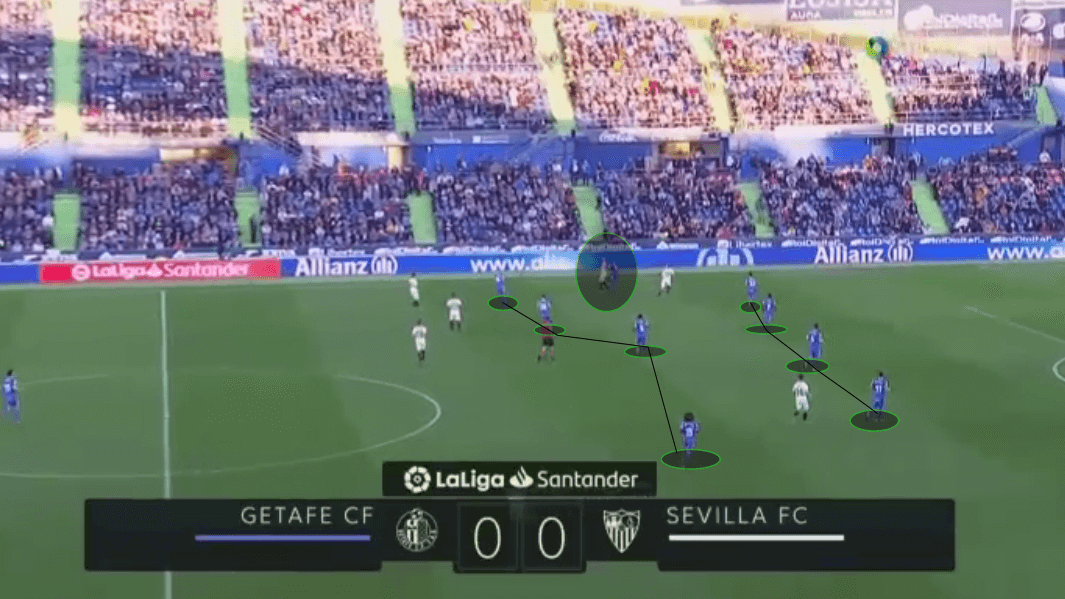
In situations when the opponents decide to go for goal kicks rather than short-passing build-up, Getafe is also adept at defending against it and winning back possession. They firstly remain compact. This gives them the much-needed structure to win the second balls or 50-50 balls. Apart from this, Getafe is very adept at winning individual battles which makes it easier to win balls from goal kicks.
In throws-in, they also feature compactness in their shape as they try to maintain or create a numerical advantage. The Getafe players would rather mark the spaces around the opponents as this gives them close proximity to the opponents and one another which allows for easy counter-pressing. The compact structure also gives them a high probability of winning second balls or loose balls.
Defending transitions
In case of losing possession, Getafe is adept at recovering possession or stopping the resulting counter-attack or transition that ensues from it. Counter-pressing, recovery, tactical fouls and compactness – these are all features Getafe use in defending transitions.
The first instinct for Getafe when they lose possession is to counter-press in a ball-oriented manner. In order to counter-press effectively, the players have to be positioned as close as possible in order to ensure central compactness.
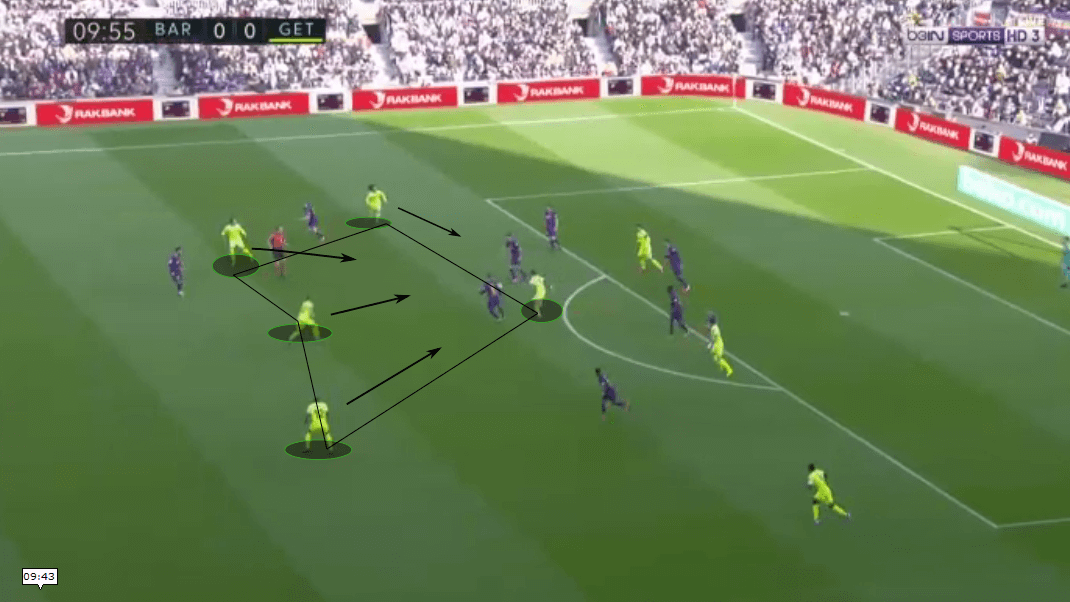
In order to ensure central compactness, either of the full-backs positions himself in the half-space with the other fullbacks, defensive midfielder and one winger. These players act as the first line when Getafe counter-press, especially in scenarios when the opposition are recycling possession after crosses.
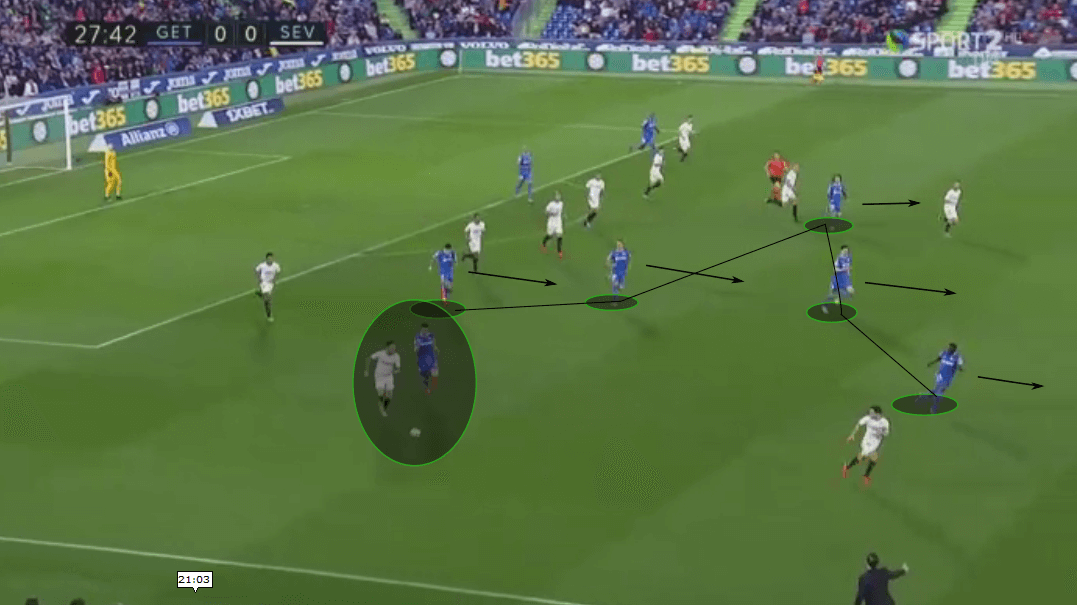
In the situation where the counter-press is bypassed or these covers are out of position, Getafe players show immense work-rate and recovery pace to get back into shape and create a defensive overload. In order to give them a better chance, one player must mark the ball-carrier to buy time.
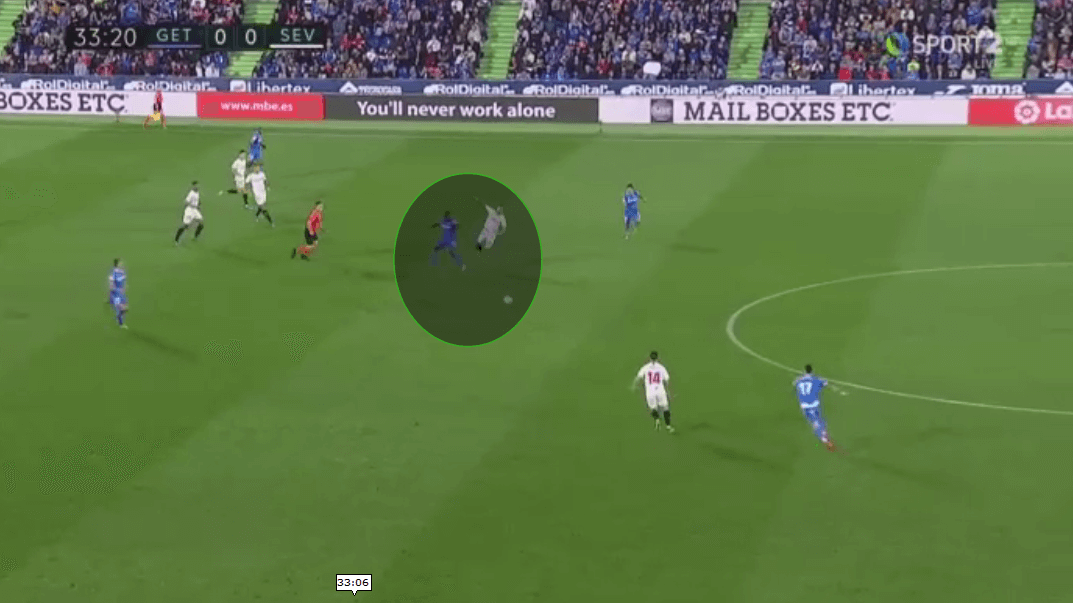
Tactical fouls or cynical fouls are another option Getafe use in defending transitions. These fouls happen in situations where they are at a numerical disadvantage, suffering from a lack of compactness in transitions or are facing clear goal-scoring opportunities.
Conclusion
Getafe’s brand of defensive football doesn’t suit everyone but it has brought success to the club after a dreadful 15/16 season. They have made themselves a very hard team to beat considering the size of the transfer budget they have in comparison to the top Spanish sides.
With that being said, however, Getafe can and still should improve on their defensive play. Controlling more space and energy by ditching the man-marking press and sitting in a more organised block could bring them more success. It will give more control to their uncontrollable chaotic style.
Also, the purchase of top transitional players in wide players and strikers will help improve their transitional threat. Apart from this, the improvement in attack will also improve their attacking dynamics.






Comments